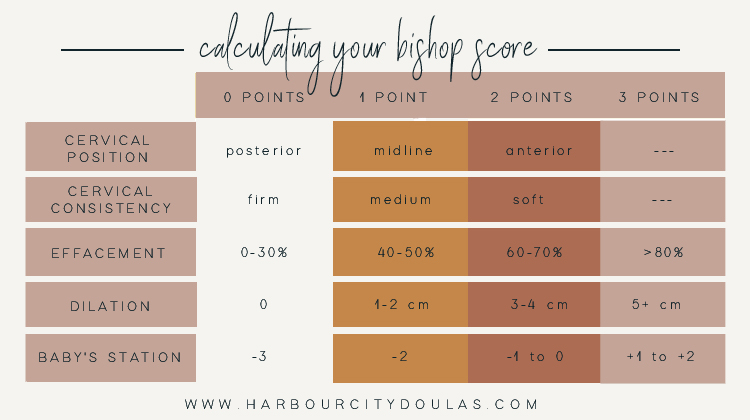Late pregnancy is a total guessing game. If I had a dime for every time someone asked me, “So, when do you think things might get started?”… well, I’d have a lot of dimes. There’s generally no way to predict anything at this stage. However, there’s one thing that can be predicted with reasonable accuracy, and that’s how likely an induction is to result in a vaginal birth. How is this done? With a cool little calculation called your Bishop Score.
The Bishop score is a system to decide how likely it is that you will go into labour soon. The score considers different factors about your cervix and the position of your baby. Each factor is given a grade, and then these grades are added up to give you an overall score.
There are several factors at play when calculating your score:
- How dilated your cervix is (0-10cm)
- How effaced your cervix is (it usually starts at about 3cm long and thins as labour progresses)
- If your cervix is soft, moderate, or firm. Your cervix will become softer before labour begins.
- The position of your cervix. During pregnancy, it remains posterior (facing your back), but as labour draws nearer it moves forward (anterior).
- The position of your baby’s head. During pregnancy, your baby’s head is high in the pelvis- called “-5 station”. Before labour begins, your baby’s head will “engage” and move to station 0. During labour, the baby will move down in your pelvis until their head is visible (+5) and the baby is ready to be born.
Typically, your Bishop score can be calculated with a simple cervical exam in your doctor or midwife’s office. Occasionally, your care provider may request that you have an ultrasound to confirm your baby’s position, your cervical activity, or to get a better look at what’s happening inside.
Each marker of your exam will receive a different “score” based on what it’s doing. Here’s the way points are handed out:

How Your Bishop Score Effects Your Induction
If you’ve got a higher Bishop score (8 or above), it means your body is already pretty much ready to go into spontaneous labour any time. If you choose to be induced at this point, you’re more likely to have a faster, easier induction that ends in a vaginal delivery.
If your score is 6 or 7, it’s pretty unlikely that labour will start imminently. An induction may or may not result in a vaginal birth- it’s important to weigh the pros and cons here!
If your score is 5 or lower, it means labour is almost certainly a good way off. It’s not likely to start spontaneously any time soon, and an induction isn’t likely to be successful.
Of course, these numbers aren’t written in stone! If there’s anything we’ve learned as doulas, it’s that birth is unpredictable at best, and that the human body is capable of some pretty amazing things (including making rapid, unexpected changes). If an induction is on the table, it’s important to discuss the pros and cons with your provider, do your research, listen to your gut, and of course- call your doula.

Recent Comments